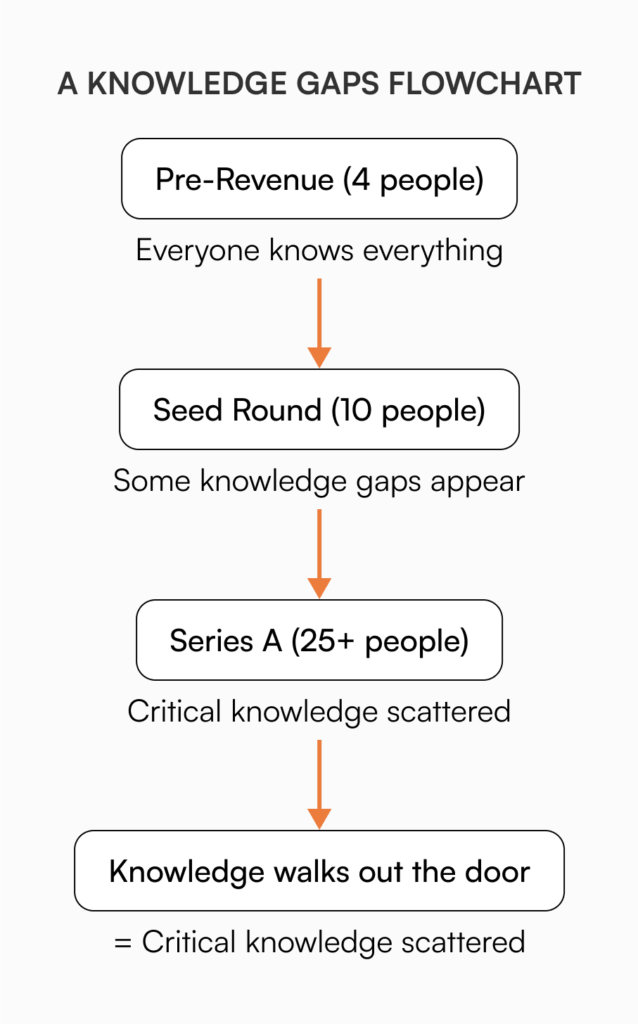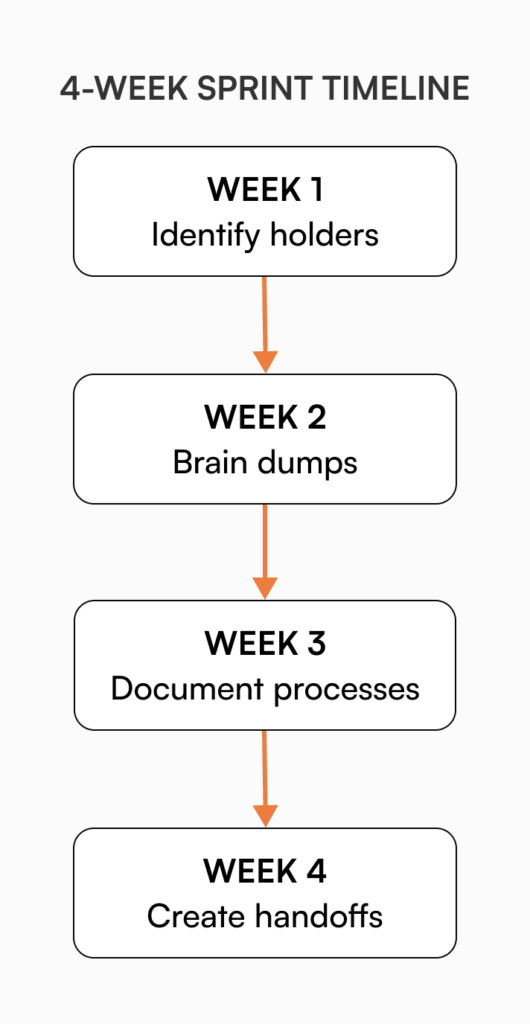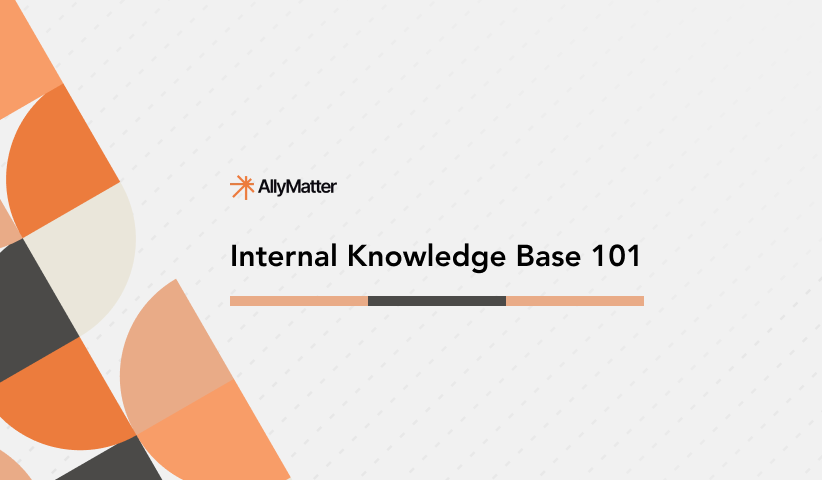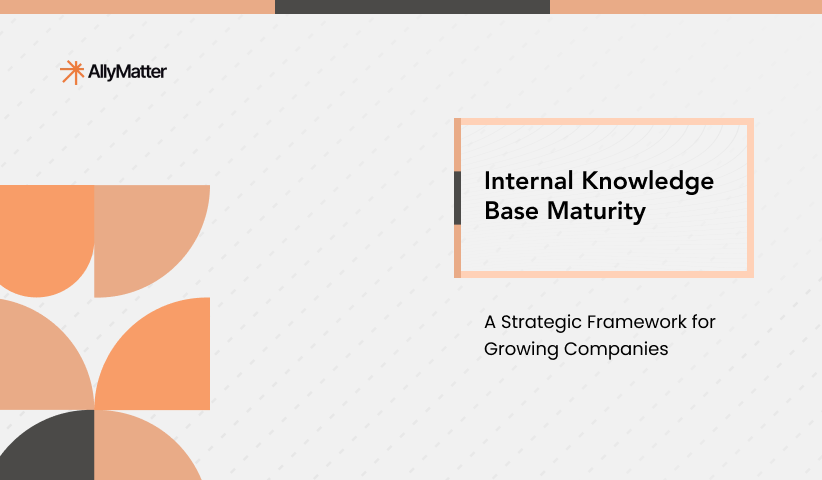Sarah was employee number three. She built your entire customer onboarding flow, knew every client’s quirks, and could diagnose any product issue in seconds. Last Friday was her last day.
Now you’re staring at her empty desk, realizing she took three years of accumulated wisdom with her. That undocumented API integration she built? No one else understands it. The relationship she nurtured with your biggest client? You’re not even sure who their main contact is. Those product decisions she influenced? The reasoning behind them left when she did.
This isn’t a story about poor retention or management. Even in the best startups, people leave. The tragedy isn’t that Sarah left – it’s that her knowledge left with her. And somewhere between pre-revenue hustle and Series A growth, you missed the critical window to capture what your early team knows before it walks out the door.
The tribal knowledge time bomb
Every early-stage startup runs on tribal knowledge. It’s not a bug; it’s a feature. When you’re four people in a room, documentation feels like procrastination. Why write down what everyone already knows?
But tribal knowledge has an expiration date. Here’s what’s really at stake:
The origin story amnesia: Your first ten customers shaped your product more than any strategy document. Early employees remember why you built that weird feature for Customer #3 or why you avoided a seemingly obvious market. When they leave, you lose the context that prevents you from repeating expensive mistakes.
The relationship black hole: Early employees don’t just know your customers – they ARE the relationship. They remember that your enterprise client hates phone calls but loves detailed emails, that your biggest user actually works at Company X but pays through Company Y, that the decision maker always loops in their technical advisor friend. These details close deals and prevent churn.
The technical archaeology: That critical system your first engineer built? It works, but no one knows why it was architected that way. The trade-offs, the constraints, the “we’ll refactor this later” decisions – all locked in someone’s head. Until it breaks at 2 AM and no one knows where to start.
The failed experiment graveyard: Your team has already tried dozens of ideas that didn’t work. But without documentation, new hires excitedly propose the same failed experiments. You waste cycles learning the same lessons twice, three times, forever.
Also read: The Power of Building Internal Documentation That Works
Why series A changes everything
The shift from pre-revenue to Series A isn’t gradual – it’s a phase change. Here’s what breaks:
Hiring velocity explodes: Pre-Series A, you hire carefully, maybe one person every few months. Post-Series A, you’re hiring five people next month. Your oral tradition can’t scale that fast. New hires drown in confusion while early employees drown in questions.
Investor scrutiny intensifies: Series A investors don’t just want growth – they want sustainable, understandable growth. When they ask about customer concentration or technical debt, “Sarah knew all that” isn’t an acceptable answer. Due diligence becomes painful when institutional knowledge is all tribal.
Complexity compounds: At ten customers, everyone knows every account. At a hundred, no single person can hold it all. The informal information networks that powered your early growth become bottlenecks. Decisions slow because context is scattered across too many minds. According to Gartner, 47% of digital workers struggle to find the information needed to effectively perform their jobs – a problem that intensifies rapidly during scale-up phases
Culture dilutes rapidly: Those unwritten rules and informal processes that made you special? They don’t transfer through osmosis at scale. Your culture becomes whatever new hires guess it is, not what founders intended.

The knowledge capture framework
You can’t document everything, and you shouldn’t try. Focus on capturing knowledge that’s both critical and at risk:
1. Customer archaeology
Document the real story of your early customers:
- Why did they really buy? (Not the official reason, the actual reason)
- What almost killed the deal?
- Who are the hidden influencers?
- What promises did we make?
- What unique workflows did we support?
Create customer timelines: “June: Almost lost them over API limits. Sarah suggested usage-based pricing. They became our biggest advocate.”
2. Product decision history
Every weird product decision has a story. Capture:
- What problem were we solving?
- What alternatives did we consider?
- Why did we choose this approach?
- What trade-offs did we accept?
- What did we learn afterward?
Format: “Feature: Custom reporting. Built for: TechCorp who threatened to churn. Trade-off: Added complexity to data model. Result: Retained customer, but support burden increased 30%.”
3. Technical architecture map
Document not just what you built, but why:
- Original constraints and assumptions
- Key architectural decisions
- Technical debt taken consciously
- Integration points and dependencies
- “Here be dragons” warnings
Include context: “Used MongoDB because founder had experience. Now hitting scale limits. Migration planned for Q3.”
4. Relationship matrices
Map the human connections powering your business:
- Customer stakeholder maps
- Vendor relationships and history
- Advisor/investor interaction patterns
- Community and partnership networks
Details matter: “Contact Jenny at CorpX through LinkedIn, not email. She screens everything. Mention her dog Max.”
5. Failure museum
Your failures are competitive advantages – if you remember them:
- Failed product initiatives
- Lost deals and why
- Hiring mistakes and patterns
- Technical approaches that didn’t scale
Be specific: “Tried SMB self-serve in March. CAC was $500 for $50/month contracts. Killed after 2 months. Learning: Our product needs high-touch onboarding.”
The pre-series A knowledge capture sprint
You don’t have months for this. Here’s a focused approach:
Week 1: Identify knowledge holders Map who knows what. Your first engineer owns technical history. Your first salesperson owns customer relationships. Create a knowledge risk matrix – what happens if each person leaves tomorrow?
Week 2: Structured brain dumps Schedule 90-minute sessions with each key holder. Use prompts:
- “Walk me through our biggest customer win”
- “What would break if you left tomorrow?”
- “What do new hires always get wrong?” Record these sessions. Transcribe later.
Week 3: Document critical paths Focus on processes that would fail without specific people:
- Customer onboarding flows
- Production deployment procedures
- Vendor management processes
- Financial operations workflows
Week 4: Create knowledge handoffs Build transition documents assuming the owner has already left. Include:
- Key relationships and how to maintain them
- Critical tasks and when they happen
- Red flags and early warning signs
- Historical context for current state

Making it stick: The living knowledge base
Capturing knowledge once isn’t enough. It needs to evolve:
The weekly download: Every all-hands, spend 10 minutes on “What we learned this week.” Document customer insights, product discoveries, process improvements. Make knowledge sharing a celebrated behavior.
Exit interview evolution: When someone leaves, don’t just ask why. Do a knowledge transfer session. What do they know that no one else does? What relationships need transitioning? What documentation is missing?
New hire annotations: Have every new hire document their onboarding confusion. What tribal knowledge did they have to excavate? Their fresh eyes reveal documentation gaps.
Decision journaling: For major decisions, assign someone to document not just what was decided, but why. Include dissenting opinions and bet-the-company context. Future you will thank present you.
Also read: Building a Future-Proof Internal Knowledge Base
The tools and systems that scale
Your knowledge base needs to grow with you:
Start simple: Pre-revenue, a shared Google Doc might suffice. But structure it from day one:
- Customer insights
- Technical decisions
- Process documentation
- Lessons learned
Scale thoughtfully: As you grow, scattered documents become their own problem. You need version control, search capabilities, and access management.
Automate knowledge capture: Build documentation into workflows. Customer call notes go straight to the knowledge base. Post-mortems automatically file to lessons learned. Make capture frictionless.
When it’s time for knowledge infrastructure
As you approach Series A, managing tribal knowledge in ad-hoc tools breaks down. You need systems that can handle your growth trajectory.
This is where platforms like AllyMatter become essential. Your tribal knowledge transforms into institutional assets with proper version control, showing how understanding evolved. When customer insights update, the right people get notified automatically. New hires can trace the history of decisions, understanding not just what you do but why.
The goal isn’t to become bureaucratic – it’s to ensure your hard-won knowledge becomes a competitive advantage rather than a departure risk.
The compound value of captured knowledge
When you nail knowledge capture before Series A, the benefits multiply:
Due diligence becomes painless: Investors ask about customer concentration? Pull up detailed relationship maps. Technical debt questions? Show documented architectural decisions. Your readiness signals operational maturity.
Scaling accelerates: New hires contribute faster when they can self-serve context. Your employee #50 can understand decisions made by employee #5. Institutional knowledge compounds rather than dilutes.
Innovation builds on history: Teams can learn from past experiments without repeating them. Your failure museum becomes an innovation accelerator. Each new hire stands on the shoulders of accumulated wisdom.
Founder freedom emerges: When knowledge isn’t trapped in specific heads, founders can focus on vision rather than being walking encyclopedias. You can take vacation without the company grinding to a halt.
Your next three moves
Knowledge capture can’t wait for “when things calm down.” Start here:
This week: List your top five knowledge holders. What would break if they left tomorrow? Schedule time with the highest-risk person.
This month: Run a knowledge capture sprint for your most critical area – probably customer relationships or technical architecture. Don’t aim for perfection; aim for existence.
This quarter: Build knowledge capture into your culture. Make it part of how you work, not extra work. Celebrate people who document. Recognize knowledge sharing in reviews.
The brutal truth? Some tribal knowledge is already gone. Early employees have left, taking insights you’ll never recover. But every day you wait, more knowledge walks out the door. Your Series A success depends not just on the team you build, but on preserving the wisdom of the team that got you here.
Why growing companies choose AllyMatter for knowledge management
When scattered documents and tribal knowledge threaten your Series A readiness, AllyMatter transforms chaos into institutional assets. Our platform ensures critical knowledge stays with your company, not in individual heads.
With intelligent organization through smart tags and metadata search, your team finds customer insights and technical decisions instantly. Granular access control means sensitive information stays protected while remaining accessible to the right people. Complete audit trails show how understanding evolved, supporting due diligence and decision-making.
As your startup scales from tribal knowledge to institutional memory, AllyMatter grows with you – ensuring competitive advantages compound rather than walk out the door.
Join our waitlist to be among the first to experience how AllyMatter preserves your startup’s competitive advantages
Frequently asked questions
When should startups start documenting tribal knowledge?
Start immediately when you reach 5-10 employees or raise seed funding. The earlier you begin, the easier it becomes to maintain as you scale.
What’s the difference between tribal knowledge and regular documentation?
Tribal knowledge includes the “why” behind decisions, customer relationship nuances, and failed experiment context. Regular documentation covers “what” and “how.”
How do you prevent knowledge capture from slowing down a fast-moving startup?
Build capture into existing workflows rather than creating separate documentation time. Record customer calls, document decisions as they’re made, and assign knowledge sharing responsibilities.
What happens if we don’t capture knowledge before Series A?
You risk losing competitive advantages, repeating expensive mistakes, struggling with due diligence, and experiencing painful knowledge gaps when key employees leave.
Which knowledge should startups prioritize capturing first?
Focus on customer relationships, product decision history, and any processes that would break if specific people left the company.


